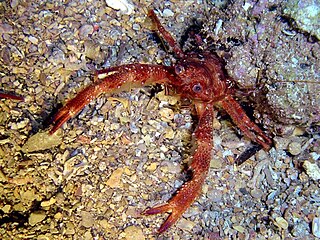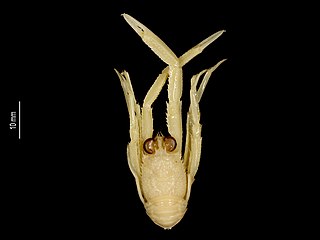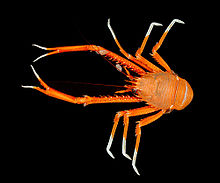
Squat lobsters are dorsoventrally flattened crustaceans with long tails held curled beneath the cephalothorax. They are found in the two superfamilies Galatheoidea and Chirostyloidea, which form part of the decapod infraorder Anomura, alongside groups including the hermit crabs and mole crabs. They are distributed worldwide in the oceans, and occur from near the surface to deep sea hydrothermal vents, with one species occupying caves above sea level. More than 900 species have been described, in around 60 genera. Some species form dense aggregations, either on the sea floor or in the water column, and a small number are commercially fished.

Galathea intermedia is a species of squat lobster in the family Galatheidae. It is found in the north-eastern Atlantic Ocean, as far north as Troms, Norway, south to Dakar and the Mediterranean Sea.

Galathea strigosa is a species of squat lobster in the family Galatheidae. It is found in the northeast Atlantic Ocean, from the North Cape to the Canary Islands, and in the Mediterranean Sea and Red Sea. It is edible, but not fished commercially. It is the largest squat lobster in the northeast Atlantic, reaching a length of 90 millimetres (3.5 in), or a carapace length of 53 mm (2.1 in), and is easily identified by the transverse blue stripes across the body.

Munidopsis is a genus of squat lobster. It is the second largest of all the genera of squat lobsters, after Munida, with over 200 species. Its members are mainly found on continental slopes and on abyssal plains. A few fossil species are also known, including specimens from the Campanian (Cretaceous).

Eumunida picta is a species of squat lobster found in the deep sea. The species is strongly associated with reefs of Lophelia pertusa, a deep-water coral, and with methane seeps. It is abundant in the western Atlantic Ocean, where it is found from Massachusetts to Colombia.

Eumunida is a genus of squat lobsters. The majority of its species are from the Pacific Ocean and are as follows:

Chirostylus is a genus of squat lobsters in the family Chirostylidae, containing the following species:
Gastroptychus is a genus of squat lobsters in the family Chirostylidae, containing the following species:
Pseudomunida fragilis is a species of squat lobster in a monotypic genus in the family Eumunididae.
Uroptychodes is a genus of squat lobsters in the family Chirostylidae, containing the following species:
Anomoeomunida is a monotypic squat lobster genus in the family Munididae. The sole a species of is Anomoeomunida caribensis. It occurs in the western Atlantic.

Crosnierita is a genus of squat lobsters in the family Munididae, containing the following species:

Heteronida is a genus of squat lobsters in the family Munididae. They occur in the western Pacific Ocean.

Leiogalathea is a genus of squat lobsters in the family Munidopsidae, containing the following species:

Neonida grandis is a species of squat lobster in the monotypic genus Neonida in the family Munididae.

Plesionida is a genus of squat lobsters in the family Munididae. As of 2017, it contains the following species:

Raymunida is a genus of squat lobsters in the family Munididae, containing the following 11 species:
Setanida cristata is a species of squat lobster in the monotypic genus Setanida in the family Munididae.

Shinkaia crosnieri is a species of squat lobster in a monotypic genus in the family Munidopsidae. S. crosnieri lives in deep-sea hydrothermal vent ecosystems, living off of the chemosynthetic activity of certain bacteria living on its setae.

Munidopsidae is a family of crustaceans belonging to the order Decapoda. The Munidopsids are the deepest-dwelling family of superfamily Galatheoidea, which comprises families Galatheidae, Munididae, Munidopsidae, and Porcellanidae.












